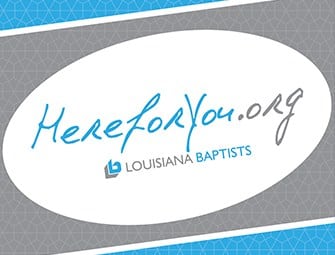By Will Hall, Baptist Message executive editor
ALEXANDRIA, La. (LBM) – In Chapter 5, Paul emphasized how we should “walk,” calling on the Ephesians to be “imitators of God” and to “walk in love … light … wisdom.” Meanwhile, he capped his discussion about righteous living by presenting how husbands and wives were to relate to each other, submitting in their respective ways to reflect the relationship of Christ with His Bride, the Church.
In this final chapter of his letter to the church in Ephesus, Paul gave instructions about the parent-child relationship immediately after addressing the marriage relationship.
Furthermore, he constructed this part of his discussion, “Children, obey your parents in the Lord, for it is right” (v. 1), around the fifth mandate of the Ten Commandments, “Honor your father and mother that it may be well with you and you may live long on the earth” (Exodus 20:12).
It is significant that Paul began his discussion about how to walk a new life, by warning the church at Ephesus, Paul was three years in Arabia, or perhaps a combination of both. But his exposition in Ephesians about how to walk – in terms of how it reflects the relationship priorities of the Ten Commandments (God, family, everyone else) – certainly shows consistency with God’s first instructions to the people of Israel.
Paul next addressed one of the most difficult relationship conditions of his time in terms of “everyone else” – the relationship between bondservant and master.
It is important to note that it appears Paul was making a distinction between debt servitude (a means to pay off what is owed another) and chattel slavery (taking someone captive as property), which the Bible condemns (Exodus 21:16; 1 Timothy 1:10). Yet, it is equally true that the fate of a bondservant could be like chattel slavery depending on the temperament of his master.
Regardless, Paul likely addressed this particular relationship from among so many others with “everyone else” because of the high number of bondservants in the Roman Empire.
Historians estimate that up to one-third of the Roman Empire population was comprised of slaves, and another third of freed slaves. Consequently, this relationship was a prevalent one at that time, and Paul addressed it bluntly by saying that you can endure any condition in life if you are first a slave to Christ (“with good will doing service, as to the Lord, and not to men”, v. 7).
Likewise, he directed believers who were masters to live differently than before in their relationships with servants (“giving up threatening, knowing that your own Master also is in Heaven, and there is no partiality with Him,” v. 9).
Finally, Paul concluded his instruction about how to walk a new life by providing some spiritual implements to employ for success in com[1]bat against “against spiritual hosts of wickedness,” (v. 12). Indeed, he used military metaphors (“armor,” vv. 11, 13) from what was likely a common sight given the ubiquitous presence of the Roman Army in the Roman Empire:
— Belt of Truth (v. 14): A soldier used his belt to cinch in all extra uniform fabric to free up their legs and give them more mobility; likewise, the Belt of Truth allows the spiritual warrior to be agile in combat.
— Breastplate of Righteous (v. 14): The breastplate protected vital organs; Likewise, righteousness protects the heart of the believer. — Shoes of Gospel (v. 15): Roman soldiers wore heavy soled boots that resembled sandals and were hobnailed to give good footing. The Gospel of peace gives believers solid footing when facing life and death situations.
Likewise, the Gospel of peace helps believers “stand firm” (v. 6), knowing that the cause for which they fight is to share the Good News with those facing eternity in Hell without it. In close combat, soldiers could even use their shoes as weapons, stomping the hobnails into the feet of the enemy.
Similarly, the Gospel of peace can be effective in opposing spiritual attackers.
— Shield of Faith (v. 16): Shields helped defend against burning arrows, deflecting some without catching fire, and smothering the flames of others that penetrated the leather but not enough to harm the bearer. The shield of faith does likewise against the fiery darts of the devil.
— Helmet of Salvation (v. 17): A soldier’s helmet protects the brain as a vital organ. Meanwhile, the Helmet of Salvation preserves the purity of the believer’s thoughts, against sin and false doctrine, as vital to a Christian’s relationship with God.
— Sword of the Spirit (v. 17): There is no more powerful weapon available to believers than the Word of God. But we must know it well to not be unwieldly with it against our spiritual foes. Paul ended his guidance by emphasizing prayer in our relationships with saints (“perseverance and supplication” v. 18) as well as sinners (“speak boldly” the Gospel, v. 19).
Crucially, Paul’s emphasis on relationships in the Book of Ephesians reflects the essential nature of our being. God stated in the beginning that He made man in His image, and that included making us a reflection of His relational nature (Father, Son, Holy Spirit; Three in One). This is intentional because before He created the universe, He desired a relationship with us. Moreover, just as He created the world to support our continuing physical existence, He also instituted relationships such as family and marriage to sustain our ongoing relational existence, too.
This is the sixth and final installment of a six-part series for the January Bible study on the book of Ephesians.



